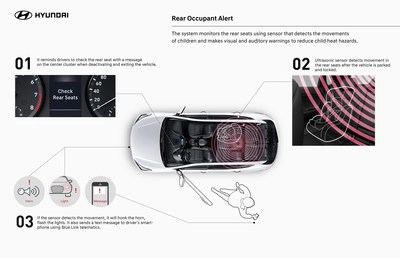Hyundai Addresses Pediatric Heatstroke Prevention
Hyundai is enhancing safety against pediatric heatstroke by implementing Rear Occupant Alert (ROA) systems across thirteen vehicle models, including the Palisade and Tucson. The ROA technology includes alerts via flashing lights, horn, and text notifications through the Blue Link system. This initiative aligns with the NHTSA's annual heatstroke prevention program, which highlights the rapid temperature increase inside vehicles. The company emphasizes the significance of safety, urging drivers to always check their vehicles before leaving.
- Hyundai includes ROA systems as standard or optional in thirteen vehicle models, enhancing safety.
- The ROA technology features innovative alerts, including text messages and horn sounds, improving child safety.
- None.
FOUNTAIN VALLEY, Calif., May 4, 2021 /PRNewswire/ -- Hyundai continues to proactively address the safety issue of pediatric heatstroke as the result of children being left unattended in vehicles in high temperatures during warmer months. The company now features thirteen products with Rear Occupant Alert (ROA) systems as standard or optional (Palisade, Santa Fe, Santa Fe HEV, Sonata, Sonata HEV, Elantra, Elantra HEV, Tucson, Tucson HEV, Tucson PHEV and Tucson N-Line, as well as Genesis GV80 and G80). The innovative ROA technology addresses and helps to prevent potentially fatal outcomes. Hyundai proudly remains the only OEM to provide such a sophisticated sensing-based alert with flashing lights, honking the horn and sending a text message via the Blue Link connected car system, directing the driver to immediately check their vehicle's backseat once they have departed and locked the vehicle.
The Palisade, Santa Fe, Santa Fe HEV, Sonata, Sonata HEV, Elantra, Elantra HEV and the all-new 2022 Tucson variants include Rear-Occupant Alert (ROA) systems as standard. Hyundai has also made its optional Ultrasonic Rear Occupant Alert, or a similar sensor-based system, available on more of its models including the Palisade, Santa Fe and all-new 2022 Tucson variants - SUV vehicles often driven by families with young children; in addition to both the Genesis GV80 and G80 vehicles.
"As we continue to develop safety systems that help protect our customers and make our roads safer, we have turned our attention to the upcoming summer months and the prevention of pediatric heat stroke," said Brian Latouf, chief safety officer, Hyundai Motor North America. "The creative ROA technologies found in Hyundai products, have the ability to alert and save precious lives during a momentary lapse in judgement and/or unawareness on how quickly a vehicles' interior can heat up in summer temperatures. Anyone who sees an unattended child in a parked car is urged to call emergency services and stay with the car until help arrives. All drivers should always lock their cars when not in use and keep keys away from children."
Hyundai currently offers two types of ROA systems to help prevent these tragedies from occurring. The ROA door-logic system detects if a rear door was opened or closed when the car was started, then reminds the driver to check the rear seat with a message on the center cluster when exiting the vehicle. The Ultrasonic ROA has the door-logic technology and an ultrasonic sensor to detect the movements of children and pets in the second-row seats. If the system detects movement in the second-row seats, after the driver leaves the vehicle and locks the doors, it will honk the horn and send an alert to the driver's smartphone via Hyundai's Blue Link connected car system (if equipped with Blue Link and the Blue Link service has been activated).
The National Highway Traffic and Safety Administration, (NHTSA) and the Department of Transportation (DOT), recently launched their annual Pediatric Heatstroke prevention and public awareness program Look Before You Lock. Highlights include recognizing a child's sensitivity to heat:
- In 10 minutes, a car's interior temperature can rise about 20 degrees.
- Even at an outside temperature of 70 degrees, the temperature inside your car can reach over 115 degrees.
- A child can die when his/her body temperature reaches 107 degrees.
If someone else is driving your child, or your daily routine has been altered, always check to make sure your child has arrived safely to their destination. Tips on NHTSA's Child Heatstroke prevention program can be found here.
Safety reminder – Please buckle-up!
Seat belts save lives every day. Always wear seat belts and use appropriate restraints for all child passengers.
The following video assets are also available:
https://www.hyundainews.com/gallery/videos/33972
https://www.youtube.com/watch?v=j8kfHgAr4-8
HYUNDAI MOTOR AMERICA
At Hyundai Motor America, we believe everyone deserves better. From the way we design and build our cars to the way we treat the people who drive them, making things better is at the heart of everything we do. Hyundai's technology-rich product lineup of cars, SUVs and alternative-powered electric and fuel cell vehicles is backed by Hyundai Assurance—our promise to create a better experience for customers. Hyundai vehicles are sold and serviced through more than 820 dealerships nationwide and nearly half of those sold in the U.S. are built at Hyundai Motor Manufacturing Alabama. Hyundai Motor America is headquartered in Fountain Valley, California, and is a subsidiary of Hyundai Motor Company of Korea.
Please visit our media website at www.HyundaiNews.com
Hyundai Motor America on Twitter | YouTube | Facebook | Instagram
![]() View original content to download multimedia:http://www.prnewswire.com/news-releases/hyundai-addresses-pediatric-heatstroke-prevention-301283122.html
View original content to download multimedia:http://www.prnewswire.com/news-releases/hyundai-addresses-pediatric-heatstroke-prevention-301283122.html
SOURCE Hyundai Motor America
FAQ
What is the purpose of Hyundai's Rear Occupant Alert (ROA) system?
Which Hyundai models feature the Rear Occupant Alert system?
When was Hyundai's announcement regarding pediatric heatstroke prevention made?
How does the ROA system alert drivers?









